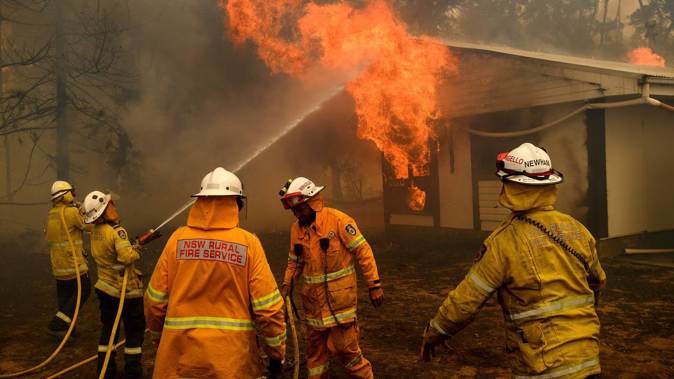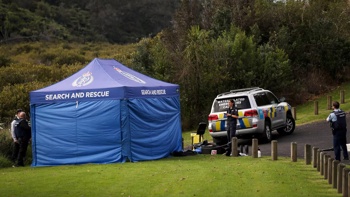
Meteorologists say it’s possible Australian smoke will again be seen in New Zealand skies this El Niño summer, with dozens of wildfires already raging across the Tasman.
Four years after Australia’s catastrophic “Black Summer” - in which fires laid waste to some 24.3 million hectares of land and left at least 34 people dead - early blazes across Queensland and New South Wales are already stoking officials’ concerns of another severe season.
Last week, officials counted 70 active fires in Queensland alone - including one that destroyed 50 homes and forced hundreds of people to evacuate.
Weather agencies had earlier warned of heightened fire risk in eastern Australia, coming with the return of one of the key climate drivers behind the 2019-20 disaster - a positive phase of what’s called the Indian Ocean Dipole - but also a potentially-strong El Niño pattern.
In New Zealand, forecasters are now pondering the potential for smoke and dust to make its way here with hot north-westerly flows predicted to regularly arrive from Australia this summer.
“The ingredients are certainly on the table,” said Niwa meteorologist Ben Noll, who last week forecast a warmer, drier three months ahead for northern and eastern regions.
“To see it in our skies, what you need is a fast start to the fire season across the Tasman, as well as a circulation pattern that favours the west-to-east transport of air from Australia to New Zealand.
“When you combine those two things together, you’re certainly increasing the chances.”
As to whether our skies might turn the same ghastly orange they did in the opening days of 2020 - when large amounts of material were ferried over by an upper-level jet of westerly winds - other elements would need to align.
“Whether that’s a southerly change moving up the South Island that drags some dust right out ahead and brings it down to a lower level of the atmosphere, or something else - these are things that just aren’t foreseeable at this point,” Noll said.
Niwa air quality scientist Dr Ian Longley - who recalled that eerie 2020 haze as “looking a bit like Mars” as he photographed it from the beach at Mangawhai Heads - thought it more likely than not that New Zealand would again see bushfire smoke this summer.
/cloudfront-ap-southeast-2.images.arcpublishing.com/nzme/QECTKB4PFPLJFC5SYCHDFEWCR4.jpg)
Smoke and ash carried over the Tasman Sea from Australia's devastating bushfires in 2019-20 briefly turned skies over the Karikari Peninsula orange. Photo / Peter de Graaf
Longley similarly considered the odds were lower for something as dramatic as that orange glow.
“Most of the air that leaves Australia passes to the north of us, and it takes the right circulation and conditions to come down and hit us instead.”
It also came down to local weather patterns - a worst-case scenario was the smoke lingering and circulating over New Zealand, rather than sweeping by - and the smoke’s height in the atmosphere.
“Again, there’s a fair degree of chance in that. Sometimes, it’s thousands of kilometres up in the air and you see the sky is a slightly weird colour, but that’s it,” Longley said.
“Or, it can come down to the surface, where you’re breathing it, you can smell it - and you can feel it in the back of your mouth.
“In 2020, the smoke was low enough for some air quality monitors to pick it up, but it could have been worse.”
Longley added the fallout from our own bushfires - for which officials are picking an elevated risk across the east of both islands over coming months - could be more impactful than that coming from Australia.
“New Zealand bushfires, of course, are much smaller affairs - but the general prediction is they’ll get more intense as time goes on.”
/cloudfront-ap-southeast-2.images.arcpublishing.com/nzme/JADDMO6BUZONE4IB7VB4GWYWZA.jpg)
Manaaki Whenua-Landcare Research scientist Dr John Hunt collects snow at Fox Glacier soon after it was discoloured by dust from Australia's catastrophic bush fires of 2019-20. Photo / Phil Novis
The outlook comes as scientists have been investigating how wind-blown material from future Australian bushfires could worsen the ongoing melting of our glaciers.
That happened as fine particles, like black carbon, settled on ice and reduced its protective albedo, or the amount of solar radiation it could reflect back.
“Once that dust comes over and gets deposited on our snow and glaciers, it just makes them a bit darker, then the albedo changes so it absorbs more incoming energy, and that’s what enhances the melt,” Victoria University glaciologist Dr Lauren Vargo said.
During the 2019-20 season, for instance, scientists initially estimated about 80 tonnes of ash had been deposited on the Fox Glacier neve (young snow) alone.
Manaaki Whenua-Landcare Research phycologist Dr Phil Novis, who’s also been researching these impacts, pointed to studies projecting an increase in wildfire risk in Australia under climate change.
“If you have significant fires going on, then the probability of an event like [2019-20] is surely higher.”
Jamie Morton is a specialist in science and environmental reporting. He joined the Herald in 2011 and writes about everything from conservation and climate change to natural hazards and new technology.
Take your Radio, Podcasts and Music with you









